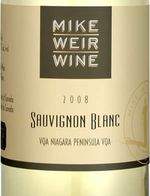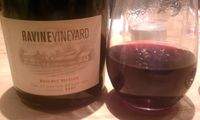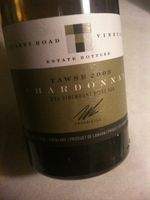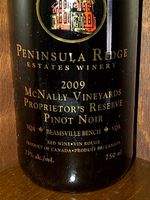For this week's WWD, our contributors and editors all picked a wine from TasteCamp 2011 — and not surprisingly we each focused on something different:
The first day of TasteCamp 2011 was spent in and tasting wines from Niagara-on-the-Lake, an area with a distinct focus on Bordeaux varieties.
Coming from another Bordeaux-heavy region, it was interesting to note the differences and the similarities.
I found quite a bit of oak in the NOTL merlots, cab francs and cab sauvs, but also a lot of intense, ripe fruit and some heat on the finish on a few. Some were absolute Parker Pleasers, which doesn't necessarily align with my own palate. (I was much more interested in the "Bench" wineries we tasted on Saturday, but more on that soon.)
We tasted my favorite of the lot Friday evening at Ravine Vineyard. The Ravine Vineyard 2007 Reserve Merlot showed plenty of ripeness in the form of sweet red cherry and faint currant and spicy cocoa notes, but far less and better-integrated oak.
More medium-bodied and food-friendly than most of the merlot we tasted, the tannins here are grippy but without rough edges and subtle acidity brings a freshness.
Another interesting point that this wine illustrated for me — Long Island isn't the only emergent region that is unapologetic about wine pricing. This wine sells for $55 in the tasting room, making it more expensive than all but a handful of Long Island merlots.
The biggest disappointment at TasteCamp North for me was the chardonnay. Niagara is pumped about its chardonnay, which seems silly, given that most of it is hidden in oak. The vast majority was buttery, smelled of popcorn, and offered nothing particularly new or interesting.
The exception — and what an exception it was — came in the wines at Tawse Winery. Winemaker Paul Pender allowed us to taste several chardonnays side-by-side; he lets the individual vineyards stand alone, which is a good idea given their differences. While I preferred Pender's unoaked chardonnay, I couldn't help but appreciate and enjoy his oaked versions, too. They're taut, textured, expressive and — here it is! — integrated.
Pender's chardonnays set a high standard that the rest of the region is not currently matching, it seems.
The challenge is finding Tawse wines in the states. But if you visit, this is a must-see. Quality across the board.
Photo courtesy of Jeff Pinhey.
 Julia Burke: Mike Weir 2009 and Peninsula Ridge 2010 Wismer Vineyard Sauvignon Blanc
Julia Burke: Mike Weir 2009 and Peninsula Ridge 2010 Wismer Vineyard Sauvignon Blanc
When I say your wine tastes South African, it's one of the highest compliments I can pay. Not everyone is familiar enough with great South African wine (or with me) to get that, but the representatives of both Mike Weir and Peninsula Ridge seemed to dig the comparison.
We tasted some amazing wines that express many facets of Niagara terroir, and I'll be writing more about them. But WWD is for cool stuff, and the similarity of these two wineries' sauvignon blancs to my favorite SA examples was too cool to ignore.
Mike Weir is not a winery I had visited before TasteCamp, but the 2009 sauvignon blanc rocked me with a nose of fresh, crisp poblano and jalapeno straight from the garden, flecked with fierce minerality — a dead ringer for Buitenverwachting Hussey's Vlei, one of the top sauvignon blancs in South Africa (yes, the name's unpronounceable and funny. But the wine will stop you in your tracks). That a wine from Niagara could taste so much like a wine from the Constantia region of SA, which is one of the country's coolest regions and certainly the closest to Niagara in terroir, was amazing to me.
Peninsula Ridge was already on my radar before our Saturday bench wineries tasting, but not for sauvignon blanc. That has changed. Their clean, flinty, gooseberry-tastic 2010 Wismer Vineyard sauv was simply awesome and crazily similar to a Stellenbosch version of the grape. Once again the clean, razor-sharp flavor profile and absence of resin or funk made me feel like I was on a picnic blanket in SA.
Sauvignon blanc wasn't necessarily the variety I was most pumped about in Niagara before TasteCamp, but it's officially on my must-try list now for future visits across the border. We have one grower on the USA side finding success with the grape and it will be interesting to see how sauv develops here. For now, it's great to know that I can get this level of sauvignon blanc from Niagara Peninsula producers.
Bryan Calandrelli:Peninsula Ridge 2009 McNally Vineyards Pinot Noir
What's amazing about an event like Tastecamp is that we all bring our collective preconceived ideas into the weekend, which ultimately sets us up for surprise or disappointment.
My expectations of Niagara pinot noir have been established by producers like Le Clos Jordanne, Tawse, Coyotes Run, Laily and a few others so when I sampled the first attempt from Peninsula Ridge I was excited enough to start rounding up people to taste it before they left.
I'd previously associated Peninsula Ridge with spectacular single vineyard Sauvignon Blancs, tasty Viognier and a handful of solid reds, but this McNally Vineyard Proprietors Reserve Pinot Noir 2009 was news to me and it sets the bar even higher for the winery.
Aromas of crushed red fruits and spice revealed the ready to drink attitude that I didn't pick up in many of the other 2009 pinot noirs I tasted over the weekend. It still showed a bit of that Niagara pinot funk that I dig but it wasn't front and center as this was clearly fruit driven. A fleshy palate with soft tannins and a graceful balance of acid really made this one stand out.
Not to mention it's listed at $25 at the winery. Next time I cross the border I'm heading straight to this winery and making my way back east with some Niagara pinot noir.
Photo Credit to Zoltan Szabo.



